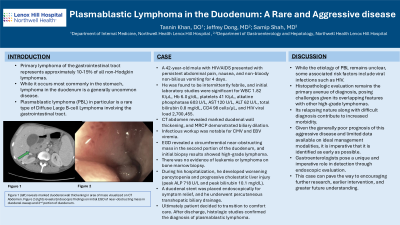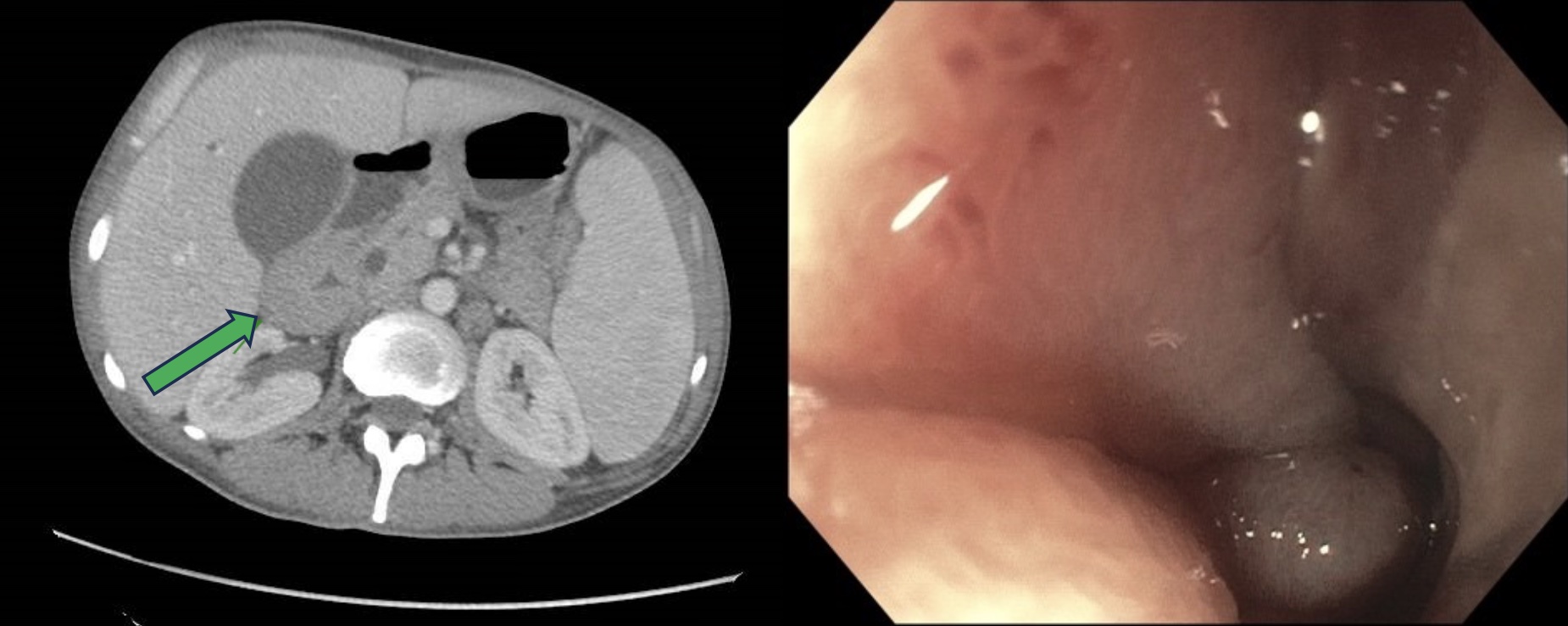Monday Poster Session
Category: Small Intestine
P3289 - Plasmablastic Lymphoma in the Duodenum: A Rare and Aggressive disease
Monday, October 28, 2024
10:30 AM - 4:00 PM ET
Location: Exhibit Hall E

Has Audio

Tasnin M. Khan, DO
Lenox Hill Hospital, Northwell Health
New York, NY
Presenting Author(s)
Tasnin M. Khan, DO1, Jeffrey Dong, MD2, Samip Shah, MD1
1Lenox Hill Hospital, Northwell Health, New York, NY; 2Lenox Hill Hospital, Northwell Health, Long Island City, NY
Introduction:
Primary lymphoma of the gastrointestinal tract represents approximately 10-15% of all non-Hodgkin lymphomas. While it occurs most commonly in the stomach, lymphoma in the duodenum is a generally uncommon disease. Plasmablastic lymphoma (PBL) in particular is a rare type of Diffuse Large B-cell Lymphoma involving the gastrointestinal tract.
There is a scarcity of existing literature on PBL and lymphomas in the gastrointestinal tract, particularly the duodenum. We present a unique case of PBL in the duodenum in an HIV patient.
Case Description/Methods: A 42-year-old male with HIV/AIDS presented with persistent abdominal pain, nausea, and non-bloody non-bilious vomiting for 4 days. He was found to be intermittently febrile, and initial laboratory studies were significant for WBC 1.82 K/μL, Hb 6.0 g/dL, platelets 41 K/μL, alkaline phosphatase 603 U/L, AST 120 U/L, ALT 62 U/L, total bilirubin 0.8 mg/dL, CD4 98 cells/μL, and HIV viral load 2,700,455. CT abdomen revealed marked duodenal wall thickening, and MRCP demonstrated biliary dilation. Infectious workup was notable for CMV and EBV viremia. EGD revealed a circumferential near-obstructing mass in the second portion of the duodenum, and initial biopsy results showed high-grade lymphoma. There was no evidence of leukemia or lymphoma on bone marrow biopsy. During his hospitalization, he developed worsening pancytopenia and progressive cholestatic liver injury (peak ALP 718 U/L and peak bilirubin 10.1 mg/dL). A duodenal stent was placed endoscopically for symptom relief, and he underwent percutaneous transhepatic biliary drainage. Ultimately patient decided to transition to comfort care. After discharge, histologic studies confirmed the diagnosis of plasmablastic lymphoma.
Discussion: While the etiology of PBL remains unclear, some associated risk factors include viral infections such as HIV. Histopathologic evaluation remains the primary avenue of diagnosis, posing challenges given its overlapping features with other high-grade lymphomas. Its relapsing nature along with difficult diagnosis contribute to increased morbidity.
Given the generally poor prognosis of this aggressive disease as demonstrated above along with limited data available on ideal management modalities, it is imperative that it is identified as early as possible. Gastroenterologists pose a unique and imperative role in detection through endoscopic evaluation. This case can pave the way to encouraging further research, earlier intervention, and greater future understanding.

Note: The table for this abstract can be viewed in the ePoster Gallery section of the ACG 2024 ePoster Site or in The American Journal of Gastroenterology's abstract supplement issue, both of which will be available starting October 27, 2024.
Disclosures:
Tasnin M. Khan, DO1, Jeffrey Dong, MD2, Samip Shah, MD1. P3289 - Plasmablastic Lymphoma in the Duodenum: A Rare and Aggressive disease, ACG 2024 Annual Scientific Meeting Abstracts. Philadelphia, PA: American College of Gastroenterology.
1Lenox Hill Hospital, Northwell Health, New York, NY; 2Lenox Hill Hospital, Northwell Health, Long Island City, NY
Introduction:
Primary lymphoma of the gastrointestinal tract represents approximately 10-15% of all non-Hodgkin lymphomas. While it occurs most commonly in the stomach, lymphoma in the duodenum is a generally uncommon disease. Plasmablastic lymphoma (PBL) in particular is a rare type of Diffuse Large B-cell Lymphoma involving the gastrointestinal tract.
There is a scarcity of existing literature on PBL and lymphomas in the gastrointestinal tract, particularly the duodenum. We present a unique case of PBL in the duodenum in an HIV patient.
Case Description/Methods: A 42-year-old male with HIV/AIDS presented with persistent abdominal pain, nausea, and non-bloody non-bilious vomiting for 4 days. He was found to be intermittently febrile, and initial laboratory studies were significant for WBC 1.82 K/μL, Hb 6.0 g/dL, platelets 41 K/μL, alkaline phosphatase 603 U/L, AST 120 U/L, ALT 62 U/L, total bilirubin 0.8 mg/dL, CD4 98 cells/μL, and HIV viral load 2,700,455. CT abdomen revealed marked duodenal wall thickening, and MRCP demonstrated biliary dilation. Infectious workup was notable for CMV and EBV viremia. EGD revealed a circumferential near-obstructing mass in the second portion of the duodenum, and initial biopsy results showed high-grade lymphoma. There was no evidence of leukemia or lymphoma on bone marrow biopsy. During his hospitalization, he developed worsening pancytopenia and progressive cholestatic liver injury (peak ALP 718 U/L and peak bilirubin 10.1 mg/dL). A duodenal stent was placed endoscopically for symptom relief, and he underwent percutaneous transhepatic biliary drainage. Ultimately patient decided to transition to comfort care. After discharge, histologic studies confirmed the diagnosis of plasmablastic lymphoma.
Discussion: While the etiology of PBL remains unclear, some associated risk factors include viral infections such as HIV. Histopathologic evaluation remains the primary avenue of diagnosis, posing challenges given its overlapping features with other high-grade lymphomas. Its relapsing nature along with difficult diagnosis contribute to increased morbidity.
Given the generally poor prognosis of this aggressive disease as demonstrated above along with limited data available on ideal management modalities, it is imperative that it is identified as early as possible. Gastroenterologists pose a unique and imperative role in detection through endoscopic evaluation. This case can pave the way to encouraging further research, earlier intervention, and greater future understanding.

Figure: Figure 1 (left) reveals marked duodenal wall thickening in area of mass visualized on CT Abdomen. Figure 2 (right) reveals Endoscopic findings on initial EGD of near-obstructing mass in duodenal sweep and 2nd portion of duodenum.
Note: The table for this abstract can be viewed in the ePoster Gallery section of the ACG 2024 ePoster Site or in The American Journal of Gastroenterology's abstract supplement issue, both of which will be available starting October 27, 2024.
Disclosures:
Tasnin Khan indicated no relevant financial relationships.
Jeffrey Dong indicated no relevant financial relationships.
Samip Shah indicated no relevant financial relationships.
Tasnin M. Khan, DO1, Jeffrey Dong, MD2, Samip Shah, MD1. P3289 - Plasmablastic Lymphoma in the Duodenum: A Rare and Aggressive disease, ACG 2024 Annual Scientific Meeting Abstracts. Philadelphia, PA: American College of Gastroenterology.
